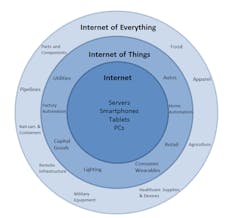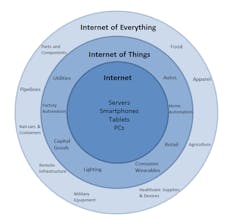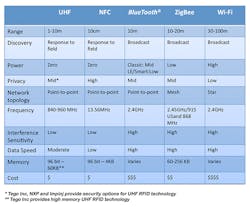It’s predicted by some that the Internet of Things (IoT) will add tens of billions of new nodes or units on the Internet. The new units will include sensors, data storage devices, computers, and infrastructure. The IoT will let them all interact with each other and be integrated into software systems and networks. The increased telemetry, along with an expected improvement in data-analysis tools, could lead to major efficiency improvements in producing and distributing goods and services, tracking and managing utilities and transportation infrastructure, and reducing lifecycle costs and risks across a range of industrial processes.
But connecting these billions of new “things” to the Internet presents a connectivity challenge not unlike the “last mile hurdle” in hooking up remote houses and farms to the electrical and telephone grids during the mid-1900s. It was relatively easy to connect households in apartment buildings in urban areas but was much more difficult and expensive connecting rural households and businesses.
And unfortunately the “things” that are going to being interconnected on the IoT tend to be much less concentrated geographically than households. Many of them also have no source of power, no network connectivity, and in many cases are located in remote or harsh environments. Some of these “things” are in fixed locations with benign environmental conditions and they will easily be connected with TCP/IP networking. And devices that connect wirelessly via Wi-Fi, ZigBee, and Bluetooth operate in broadcast mode, meaning they’re “always on.” So they are power-hungry and require batteries.
But many more, especially sensors, are likely to require less expensive connections that do not require batteries and can withstand shock, heat, cold, radiation, and other environmental extremes.
One potential solution to the “last-30-feet” IoT problem are UHF tags, also known as RFID tags. They lack their own IP addresses, but they can connect to the Internet through a reader on the network. RF technology was invented in 1948 and has been standardized across many industries, so there is already a large, installed base of readers and billions of tags in use.
As tag functions and memory increased, and software on readers evolved as well, letting readers help solve “last 30 feet” problem for the IoT. Instead of the network reaching a set-top box in someone’s living room, the network instead reaches a set of readers that collectively reach millions of high-memory UHF tags, thus forming a powerful and intelligent network of objects.
A key feature of these tags, in terms of connecting objects to network endpoints, is that they are both wireless and passive. “Passive” refers to the fact that they operate without a local power source—they are not plugged into the wall nor do they use batteries. UHF tags do not “talk” unless prompted by a nearby RF reader responding to the tag’s RF field. Tags get their power over-the-air from RF energy emanating from a reader. This lets UHF network items where batteries are not economical or even an option such as in sensors embedded inside structural materials like carbon fiber and concrete to monitor vibration, stress and strain, or excessive movement. It’s simply not possible to rip apart these materials to replace batteries.
Passive technology is a cost-effective alternative for a wide range of applications. In manufacturing factories, passive tags can be used to record the time and location of each item as it passes a fixed scanner without requiring each tag to be battery-powered. Oil pipes, aircraft components, prosthetic components, and containers of blood can be interrogated by simple scanners, wherever they are.
Some passive UHF tags, like those from Tego Inc. (tegoinc.com), Waltham, Mass., can cache updatable product history data, making data available at the point of use, as well as aggregating it in cloud databases for analysis. The chips’ architecture can survive extreme cold or heat, radiation, and physical shock, so they can handle connectivity and local data caching in applications that cannot use other connectivity technology. Such applications include industrial furnaces, glass-making machinery and cryogenically stored products.
UHF technology is particularly well suited to connecting items at the furthest edges of the network, thus giving access to many more “things.” The communications protocol was designed to work in noisy RF environments and in the presence of many other similar tags, which are becoming more common with more items carrying tags. Tags can only be reached through a proximate reader, greatly reducing the risk of unauthorized access. High-memory tags can also use industry-standard security software, simplifying the task of integrating them into existing systems.
The return signal path also requires no power contribution from the UHF tag and resists interference. Higher-frequency RF signals such as Wi-Fi and ZigBee, on the other hand, are highly sensitive to other RF noise, which degrades the signals’ ability to be transmitted through materials.
The best IoT designs feature several wireless technologies for the best connectivity fit for a particular network. For example, device-to-device communications get the higher data and faster throughput communications, while point-to-point communication works well for things toward the edge of the network.
As IoT continues its rapid growth, durable, high-memory tags will be critical for extending connectivity to large market segments not well served by more expensive, active “broadcast” connectivity methods. The tags’ small form factor, low power consumption, and low cost will make it possible to tag a much larger number of “things.” These “edge” things will likely to be the majority of “things” in the IoT.
High-memory RF tags continue to advance and will become more efficient at sharing data to communicate the “who, what, when, where, and how” that feeds into the network, opening the door to new applications and making many assets “smart.”
Timothy Butler is the CEO of Tego Inc.



